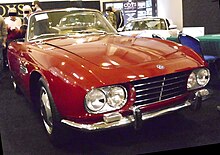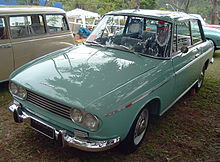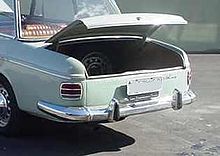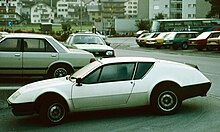Carrozzeria Fissore

The Carrozzeria Fissore was an Italian body manufacturer from Savigliano near Turin ( Piedmont ).
history
The company was founded in 1920 by the brothers Antonio, Bernardo, Giovanni and Costanzo Fissore and in the first years of its existence it dealt initially with the manufacture of carriages and later with the repair of cars and trucks. From 1936, when Bernardo Fissore took over the management of Company took over, they began to manufacture special bodies for automobiles, particularly hearses, postal vehicles and small buses. During the Second World War, the product range changed; as in many other factories, military vehicles were now being produced.
After the war, Fissore turned back to civil vehicles. The company designed the design in its own studio and also built the bodies in its own workshops. In 1947, the first station wagon was built on the serial chassis of the Fiat 1100, which was named Giardinetta . This term, which was first used by Fissore, is still in use today in Italy for station wagons and was found both in the corresponding derivatives from Fiat (e.g. Fiat 500) and Alfa Romeo (e.g. Alfa 33) . In 1953 the Coupé 1000 TV designed by Mario Revelli was presented, which was based on the chassis of the Fiat 1100 and had its own line. The car became the first major success for Carrozzeria Fissore. Other models on different Fiat chassis followed. With increasing success, the company grew, so that by the mid-1960s it had almost 200 employees. During this time, Fissore began working for other automakers as well. Either body designs were created here or entire vehicles were manufactured in individual or small series, among them DKW , TVR and de Tomaso . Even if the Carrozzeria Fissore did not play in the league of Pininfarina , Bertone , Michelotti or Pietro Frua , it was a veritable design studio and bodywork factory with a solid reputation and national importance.
In 1969, the Carrozzeria Fissore was commissioned by Monteverdi to manufacture a large part of the sports cars in the high-speed series. This secured the company's existence for the next few years, even if the number of 100 units per year initially announced by Monteverdi was probably never reached. This changed when Monteverdi began producing the Safari SUV in large quantities. This showed that a purely manual production, as Fissore had previously practiced, could not ensure the desired quantities. Therefore, Fissore and Monteverdi invested in at least partially industrial production with sheet metal presses and the like. Ä. In return, Monteverdi received larger shares in Carrozzeria Fissore and ultimately took over the plant completely in the late 1970s. The manufacture of Monteverdis made up the bulk of the Fissore production during this period. However, prototypes and one-offs were still being made for other companies.
When Monteverdi gave up car production in 1984, this also meant the end for Carrozzeria Fissore. Due to a lack of follow-up orders, the company was liquidated in 1984.
Rayton Fissore , founded in 1976, has no legal relationship with Carrozzeria Fissore. This is an independent body shop that was founded and run by Giulio Malvino . The similarity of the name is due to the wife of Malvino, who was born in Fissore and comes from the family that ran the Carrozzeria Fissore. Rayton Fissore produced the Magnum from 1985 ( sold as Laforza in the USA ), an independently designed and luxuriously equipped off-road vehicle with an Iveco chassis, which was not dissimilar in concept to the Monteverdi Safari, apart from that, nothing with the Swiss-Italian car had to do.
vehicles
Fissore and Fiat
In the 1950s and 1960s in particular, Fissore manufactured a number of special bodies on Fiat chassis. Some of them were produced in small series. These included:
- Fiat 1100 TV Fissore Coupé (1953), a coupé with a pontoon body based on the Fiat 1100. Several copies were produced and Fissore described it as the first great success.
- Sabrina , a four to six-seater car based on the Fiat Multipla with a heavily modified body.
- 1500 Coupé , a two-door model based on the Fiat 1500, presented in Turin in 1959.
- Mongho 650 , a tight coupe based on the Fiat Nuova 500 with a design by Alessandro Sessano in the angular style of the early 1970s. The engine of the Fiat 500 had been tuned by Giannini , so that the car offered quite lively performance. Fissore built the prototype, which remained a one-off. The car is in Italy today .
- Fissore 127 Scout , an open fun car in the style of the Citroën Méhari with the technology of the Fiat 127 . The car was first developed in 1971 by a company called MAINA and introduced as Gypsy . MAINA could not build the car in large numbers itself and quickly passed the production of the car on to Carrozzeria Fissore, which manufactured and marketed it under its own name. Initially, body parts made of fiberglass-reinforced plastic were used, later made of sheet steel. The Scout was a very successful car that was also available in Germany. Autokinitoviomihania Ellados from Greece received a license .
Fissore and OSCA
In 1962, in the early 1960s, Fissore designed and built some bodies for OSCA, a company owned by the Maserati brothers . The chassis of the OSCA 1600 was used for this. Fissore initially designed an elegant, tightly cut notchback coupé with a narrow, retracted front section and twin headlights lying next to each other. The roof line was angular with filigree A, B and C pillars. The coupe was produced in a total of 22 copies. Two vehicles were built as a convertible.
Fissore and DKW
In the early 1960s, Carrozzeria Fissore had business contacts with DKW and the German Auto Union . Three DKW models, which were to be built in Brazil by Veículos e Máquinas Agrícolas (Vemag) and sold on the South American market, were initially revised by Fissore. It refers to
- the DKW F93 (3 = 6). The vehicle was built by Vemag in Brazil from 1958 to 1967 and sold under the name DKW-Vemag Belcar (= beautiful car). The station wagon version was called Vemaguet . While keeping the technology unchanged, Fissore revised primarily the front and rear sections. The sweeping fenders were retained, but the DKW-Vemags were equipped with front-hinged doors and double headlights. A total of about 51,000 copies were made.
- Another vehicle was the DKW-Vemag Fissore , a two-door sedan with a smooth-surfaced pontoon body, for the front of which Fissore took over the features of the OSCA-1600 coupé that had just been introduced. The body of the body was roughly similar to the German DKW F 102. A station wagon was also built as a one-off. The DKW-Vemag Fissore was basically a new body version of the Belcar , which, given the updated, much more elegant design, was sold at a price about 25% higher than the Belcar . With its two-stroke engine, however, the Fissore was not a serious competitor for American or Italian imports. Between 1964 and 1967 no more than 2,500 DKW-Vemag Fissore were produced. The car is a sought-after rarity in South America today.
- Finally, Fissore designed coupes and spiders based on the Auto Union SP 1000. The Fissore designs moved away from the originally copied Ford Thunderbird. There were license productions of the coupes and spiders in Argentina and Spain .
Fissore and De Tomaso
Fissore designed the Vallelunga model for de Tomaso . First, a Spyder was created that did not get beyond the prototype stage. Shortly thereafter, Fissore designed a closed version, around 50 copies of which were manufactured by the mid-1960s. However, series production did not take place at Fissore - as might have been hoped - but at Carrozzeria Ghia , which at the time partially belonged to Alejandro de Tomaso .
Fissore and Monteverdi
The business relationship between Fissore and the Swiss sports car manufacturer Monteverdi was of particular importance. It ensured the survival of the Carrozzeria Fissore in the 1970s.
Initially, Monteverdi had his coupé designed and built by Pietro Frua. However, in 1968, after only six months, Monteverdi parted ways with Frua, because its factory in Turin did not have the necessary capacities for the manual production of the high-speed models in the quantity Peter Monteverdi wanted. Initially, Monteverdi commissioned Carrozzeria Fissore with the production of sports cars in the previous Frua design; after Pietro Frua had successfully sued license fees, however, Monteverdi changed the design of the sports car. It is unclear whether this body was designed by Fissore or whether the design actually came from Peter Monteverdi himself, as he repeatedly claimed. In any case, Fissore never denied Monteverdi's claim. It is possible that the baselines of the coupé came from Monteverdi, while Fissore took care of the detailed implementation. The same may apply to the derivatives of high-speed, that is, to the coupés with a short wheelbase, the convertibles and the sedans.
The production process was complicated. First a chassis was manufactured in Basel, which was then connected to the body in Savigliano. The car was then returned to Basel, where the engine and drive components were fitted and completed in the Monteverdi workshop.
What is certain is that Fissore made many, but not all, of the high-speed series Monteverdis. In addition to Fissore, the Poccardi and Embo factories were busy manufacturing individual vehicles. This diversification was probably due to capacity reasons.
Fissore also made the bodies for the successful Monteverdi Safari . It is not certain whether the Monteverdi Sierra , a modification of the Dodge Aspen , was built near Fissore. This is countered by the fact that no completely separate body had to be built for this model; rather, only some add-on parts such as fenders and bonnets were replaced.
More designs
- Fissore designer Trevor Fiore designed a two-seater coupé with tight lines for TVR . Before it went into production, TVR sold the rights to the construction to a TVR dealer who launched it under the name Trident and sold around 220 copies by 1976.
- Trevor Fiore designed a successor to the A 110 for Alpine in the late 1960s. Before the designs for the car that would later become the A 310 could be implemented in France, Monteverdi took over the lines for his own mid-engine coupé called Hai . While Peter Monteverdi claims to have designed the shark himself, according to Fiores, Monteverdi looked at the Alpine design from him and later used it for his own car without a license. In any case, the similarities between the Alpine A 310 and the Monteverdi Hai are obvious.
- Fissore manufactured four four-door convertible versions of the Opel Diplomat B for Opel in the early 1970s . It stayed with the four copies. All of them still exist.
- Otas , a small sports car based on the Autobianchi A112.
literature
- Paolo Fissore, Carrozzeria Fissore , 1991.








